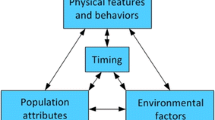Abstract
It is possible to predict future life forms? In this paper it is argued that the answer to this question may well be positive. As a basis for predictions a rationale is used that is derived from historical data, e.g. from a hierarchical classification that ranks all building block systems, that have evolved so far. This classification is based on specific emergent properties that allow stepwise transitions, from low level building blocks to higher level ones. This paper shows how this hierarchy can be used for predicting future life forms.
The extrapolations suggest several future neural network organisms. Major aspects of the structures of these organisms are predicted. The results can be considered of fundamental importance for several reasons. Firstly, assuming that the operator hierarchy is a proper basis for predictions, the result yields insight into the structure of future organisms. Secondly, the predictions are not extrapolations of presently observed trends, but are fully integrated with all historical system transitions in evolution. Thirdly, the extrapolations suggest the structures of intelligences that, one day, will possess more powerful brains than human beings.
This study ends with a discussion of possibilities for falsification of the present theory, the implications of the present predictions in relation to recent developments in artificial intelligence and the philosophical implications of the role of humanity in evolution with regard to the creation of future neural network organisms.
Similar content being viewed by others
REFERENCES
Bertalanffy, L. von (1968). General System Theory. Braziller, New York.
Close, F. (1983). The cosmic onion: Quarks and the nature of the universe. American Institute of Physics, USA.
Dawkins, R. (1976). The selfish gene. Oxford University Press, Oxford.
Eigen, M. and P. Schuster (1977). The hypercycle: a principle of natural self-organisation, Part A: The emergence of the hypercycle. Naturwissenschaften 64: 541.
Feibleman, J.K. (1954). Theory of integrative levels. British Journal for the Philosophy of Science 5: 59-66.
Happel, B.L.M. (1997). Principles of neural organisation: Modular neuro-dynamics. PhD thesis, 125 pp.
Heylighen, F. (1995). Systems as constraints on variation. A classification and natural history of metasystem transitions. World Futures 45: 59-85.
Holland, J.H. (1998). Emergence from chaos to order. Oxford University Press, Oxford.
Jagers op Akkerhuis, G.A.J.M. and N.M. van Straalen (1998). Operators, the Lego bricks of nature: evolutionary transitions from fermions to neural networks. World Futures 53: 329-345.
Kauffman, S.A. (1993). The origins of order: Self-organisation and selection in evolution. Oxford University Press, Oxford. 709 pp.
Kelly, K. (1994). Out of control. The rise of neo-bological civilisation. A William Patric Book. Addison Wesley Publishing Company, Reading.
Koestler, A. (1978). Janus, a summing up. Hutchinson & Co., London.
Kurzweil, R. (1999). The age of the spiritual machines. When computers exceed human intelligence. Viking, New York.
Laszlo, E. (1994). From GUT's to GET's: Prospects for a unified evolution theory. World Futures 42: 233-239.
Murre, J.M.J., R.H. Phaf and G. Wolters (1989). Calm networks: a modular approach to supervised and unsupervised learning. Proceedings of the International Joint Conference on Neural Networks, Washington DC, New York: IEEE Press: 649-656
Murre, J.M.J., R.H. Phaf and G. Wolters (1992). CALM: Categorising and learning module. Neural Networks 5: 55-82.
Simon, H.A. (1962). The architecture of complexity. Procedings of the American Society for the Philosophy of Science 106: 467-482.
Teilhard de Jardin, P. (1969). The future of man. Editions de Seuil V, Paris, (1946).
Warwick, K. (1997). The march of the machines. Why the new race of robots will rule the world. Century Books Ltd., London.
Author information
Authors and Affiliations
Rights and permissions
About this article
Cite this article
Akkerhuis, G.J.o. Extrapolating a Hierarchy of Building Block Systems Towards Future Neural Network Organisms. Acta Biotheor 49, 171–189 (2001). https://doi.org/10.1023/A:1011949326096
Issue Date:
DOI: https://doi.org/10.1023/A:1011949326096




